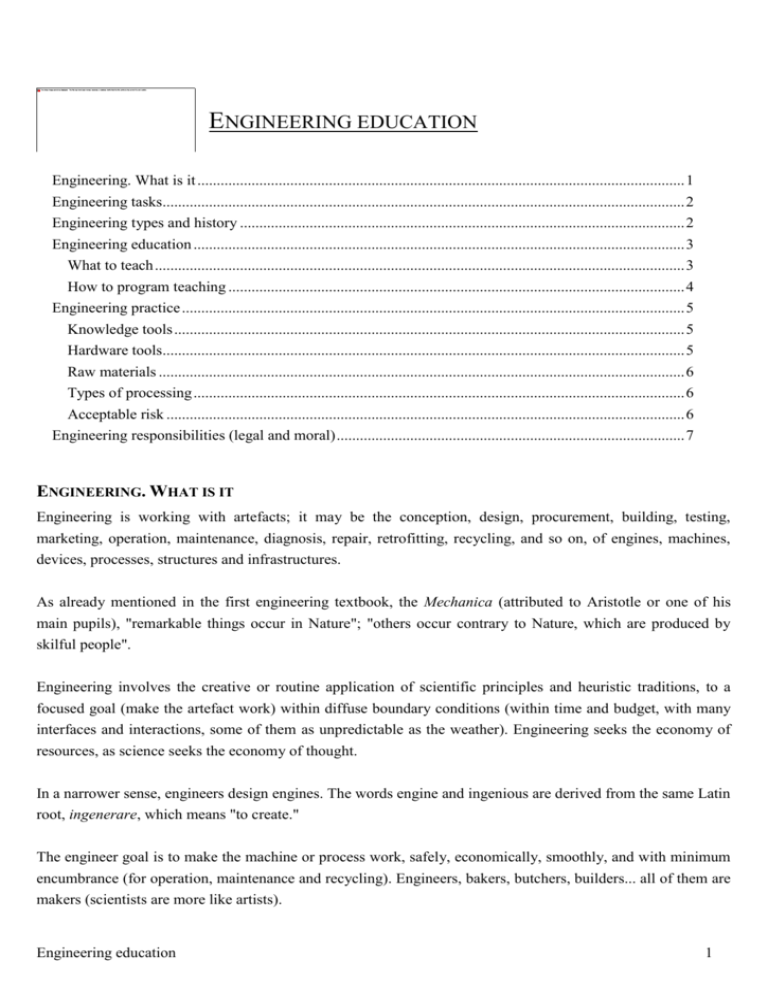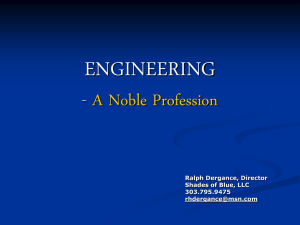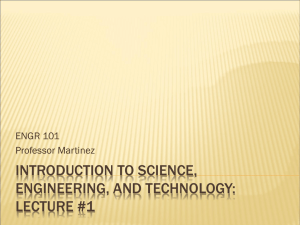Engineering. What is it
advertisement

ENGINEERING EDUCATION Engineering. What is it .............................................................................................................................. 1 Engineering tasks....................................................................................................................................... 2 Engineering types and history ................................................................................................................... 2 Engineering education ............................................................................................................................... 3 What to teach ......................................................................................................................................... 3 How to program teaching ...................................................................................................................... 4 Engineering practice .................................................................................................................................. 5 Knowledge tools .................................................................................................................................... 5 Hardware tools....................................................................................................................................... 5 Raw materials ........................................................................................................................................ 6 Types of processing ............................................................................................................................... 6 Acceptable risk ...................................................................................................................................... 6 Engineering responsibilities (legal and moral) .......................................................................................... 7 ENGINEERING. WHAT IS IT Engineering is working with artefacts; it may be the conception, design, procurement, building, testing, marketing, operation, maintenance, diagnosis, repair, retrofitting, recycling, and so on, of engines, machines, devices, processes, structures and infrastructures. As already mentioned in the first engineering textbook, the Mechanica (attributed to Aristotle or one of his main pupils), "remarkable things occur in Nature"; "others occur contrary to Nature, which are produced by skilful people". Engineering involves the creative or routine application of scientific principles and heuristic traditions, to a focused goal (make the artefact work) within diffuse boundary conditions (within time and budget, with many interfaces and interactions, some of them as unpredictable as the weather). Engineering seeks the economy of resources, as science seeks the economy of thought. In a narrower sense, engineers design engines. The words engine and ingenious are derived from the same Latin root, ingenerare, which means "to create." The engineer goal is to make the machine or process work, safely, economically, smoothly, and with minimum encumbrance (for operation, maintenance and recycling). Engineers, bakers, butchers, builders... all of them are makers (scientists are more like artists). Engineering education 1 ENGINEERING TASKS The genuine task of engineering is the technical design, and a very sound scientific background is required (but the main goal of engineers is to do, while the goal of scientists is to know). Project management, marketing, operation and maintenance are engineering tasks for sophisticated machines and processes (e.g. for a ship, but not for a light bulb, although the conception of a light bulb may be more ingenious than that of a ship). Until the 18th century, the engineer practice was rarely distinguished from that of the scientist, the inventor, or the builder. In order of decreasing emphasis on science, the major functions of all engineering branches are the following: Research. Using mathematical and scientific concepts, experimental techniques, and inductive reasoning, the research engineer seeks new principles and processes. Development. Development engineers apply the results of research to useful purposes. Creative application of new knowledge may result in a working model of a new electrical circuit, a chemical process, or an industrial machine. Design. In designing a structure or a product, the engineer selects methods, specifies materials, and determines shapes to satisfy technical requirements and to meet performance specifications. Construction. The construction engineer is responsible for preparing the site, determining procedures that will economically and safely yield the desired quality, directing the placement of materials, and organising the personnel and equipment. Production. Plant layout and equipment selection are the responsibility of the production engineer, who chooses processes and tools, integrates the flow of materials and components, and provides for testing and inspection. Operation. The operating engineer controls machines, plants, and organisations providing power, transportation, and communication; determines procedures; and supervises personnel to obtain reliable and economic operation of complex equipment. Management and other functions. In some countries and industries, engineers analyse customers' requirements, recommend units to satisfy needs economically, and resolve related problems. Although sometimes forgotten by both, employers and employees-to-be, engineers should be hired not because they know the answer to the problem but because they know how to find answers to problems. ENGINEERING TYPES AND HISTORY Major engineering fields and a list of historical achievements follows. Mechanical engineering o Neolithic: thrower, lever, wedge, pulley, bellow, boat, wheel and axle, lathe, waterwheel, windsail, windmill. o Middle Age: clock, fire arm. o Industrial revolution: heat engine (steam, gas, petrol, nuclear), locomotive, car, airplane and spacecraft. To better grasp this revolution, compare the power of different systems: person 10 2 Engineering education 2 W, beast 103 W, car 105 W, large train 107 W, large ship or aeroplane 108 W, nuclear power station 109 W. Civil engineering o Neolithic: building (pyramids). o Ancient Age: temple, road, bridge, harbour, aqueduct, sewer. o Middle Age: cathedrals o Industrial revolution: railway, tunnel, canal, dam. Chemical engineering o Neolithic: mining, metals, ceramic, textile.. o Industrial revolution: mining, chemicals, fuels, polymers, pharmaceuticals. Electrical engineering o Industrial revolution: electrical motor, electrical lamp, telegraph, telephone, radio, TV, PC. Nuclear engineering o Industrial revolution: nuclear power station, radiotherapy, radiodiagnosis (medical and industrial). Bio engineering o Industrial revolution: X-ray, food industry, proteases. Systems engineering is not a branch of engineering (as civil, mechanical, electrical, chemical,..) but the technique for applying knowledge, from all branches of engineering in combination, to solve complex engineering problem (with many interactions), usually with heavy human-machine interfacing. ENGINEERING EDUCATION Becoming a knowledgeable engineer (specially if involved in design), demands from that person to get educated and to get educated help (one cannot do everything). Education is the first step even to get educated help. What to teach Engineering education aims at mastering reliable prediction (for reliable execution), i.e. letting the student be able to foretell suitable possibilities, predict the outcome of future events, and so on, within acceptable social, economic and technical constraints. But who says what must be taught: professors, pupils, employers, social committees? As for other business, engineering education has its customers (clients) and suppliers (providers). Educational institutions, as any other business, have to keep their customers satisfied. But, who are the customers? 1) the student's family in a private system (like in ancient Greece and Rome), 2) the industry that demands the engineers (and pays the Institution) in a market-regulated system, 3) the Government that creates the engineering schools to form its military engineers (army, navy, airy), 4) the society that promotes equal opportunities in higher education as well as compulsory primary education, or 5) a combination of the formers. The latter seems the right answer today. There are three traditional groups of subject-matter to teach to form an engineer (although the first might be left for pre-engineering studies and the last for post-engineering studies: o Foundations: mathematics, physics, chemistry, biology, graphics. Engineering education 3 o Technologies (a kind of active fibres in the composite engineering skills): mechanics, thermodynamics, electromagnetism, fluids, materials. o Management (a kind of matrix in the composite engineering skills): effective communication (oral, written, graphic), problem-solving strategies, decision-making, safety and quality assurance, project management, economics and business administration, social and legal factors, aesthetic factors. Problem solving is the key to engineering practice. The problem may involve quantitative or qualitative factors; it may be physical or economic; it may require abstract mathematics or common sense. Of great importance is the process of creative synthesis or design, putting ideas together to create a new and optimum solution. So crucial to engineering is problem solving, that there has always been compulsory to carry-out a capstone project before graduation (that depending on the level may be an implementation project, a design project or a research project). After agreement on what to teach, how to do it unveils further controversy. How the timeline should be laid down, all fundamentals first, or in parallel. Where to place the emphasis, on fundamentals, in generic applications, in actual case studies. Should the teaching be done by discipline specialists or by engineers (e.g. calculus by mathematicians or by engineers that may know their actual needs). Should the learning foster group activity, as in real engineering practice, promote solitary work (individual qualification). And evaluation of student learning posses further questions (see Learning and teaching). How to program teaching Horizontally 1st year: mathematics, physics, chemistry, biology, graphics. 2nd year: differential equations, mechanics, thermodynamics, electromagnetism. 3rd year: fluid mechanics, materials and structures, propulsion, automation, lab-work 4th year: specialities, design, codes, projects, management, business, project-work. Vertically 1st cycle (4 years, bachelor): mathematics, physics, and technologies for a BE degree. 2nd cycle (2 years, master): mathematics, physics, and technologies for ME degree. 3rd cycle (3 years, doctor): mathematics, physics, and technologies for PhD degree. Where to place the emphasis: in the foundations?, in the basic technologies?, in the applications?, in the main driver of the profession?, in its business? The least risky choice is on the basic technologies (mechanics, thermodynamics, electromagnetism, fluid mechanics, materials and structures, automation) because of their balance between applicability and obsolescence, but industry's point-of-view is shifted to more direct, shortterm, productive applications. Design drivers have had an evolution in our society. Initially the driver was mechanic (how to translate rotatory motion to linear motion, how to produce vapour-tight sliding joints), afterwards it was structural (how to withstand loads), later hydro- and aerodynamic, more recently it has been electronic (sensing, control and automation), and today it is information and communication (software and system engineering). Engineering education 4 In practice, it has been found so difficult to satisfy with a common 1st cycle (bachelor engineer) the goals of a practitioner that goes directly to industry and that of a designer and or researcher that have to follow the 2 nd and perhaps the 3rd cycle, that the actual approach is to have different institutions that offer the 1st cycle weighted with more fundamentals or more applications, for the student to choose according to their wills. To homogenise and make the process more efficient, each Institution has its own entrance examination. ENGINEERING PRACTICE Engineering practice may vary according to the main task performed: design, building, operation. A block diagram of the flow of knowledge and materials for these three different activities may be: Fig. 1. Example of flow diagrams in design, in manufacture, and in operation. Crafts can be often characterised by the tools they use to make their work. Working without tools may be impossible; working with exotic tools may be expensive and inefficient. Knowledge tools Textbooks of well-established theories: General Physics, Mechanics, Thermodynamics,... Handbooks and data bases of empirical properties and methods. Standard mathematical formulas and procedures (e.g. root-finder, statistics, differential eq.) Standard graphical drawing and plotting. The are usually included in the math package. Engineering codes and standards of good practice (recommended or enforced), issued by the administration or by learned societies. Hardware tools Pen and pencil Hand calculator. PC (today popular tools are: Word, Excel, PowerPoint, Maple, FEM, CFD, Visual Basic,..). Office (desk, shelves, handbooks, codes, office tools, archives, secretaries). Laboratory for preliminary and auxiliary tests (meters, glass-ware, power, sink,...). Engineering education 5 Mechanical workshop. Electrical and electronic workshop. Laboratory for prototype testing. Raw materials From the atmosphere: air and its subproducts (N2, O2, Ar,...). From the hydrosphere: water and its subproducts (H2, NaCl, Na, Cl, Mg, D2O,...). From the lithosphere: minerals (metals, chemicals, fuels,...), oil, natural gas. From the biosphere: crops (food, energy), fish and animals (food, drugs), wood (building, paper). Types of processing Engineering processing used to be dependable, i.e. find a natural resource, make a product and forget about the side-effects in the process. Most human-made dependable processes were recycled off-line by Nature, but sometimes with too long characteristic times that forced humans to move away when their waste made the habitat unbearable. Sustainable development dictates a more cyclic type of engineering processing, as illustrated in the energy case below, although quantum jumps may be unfeasible and some hybrid type of processing may pave the way. Fig. 2. Example of processing loops in energy generation. Acceptable risk The more powerful the machine or the structure, the more damage it may cause. This is a reason way the acceptable risk is widely different for the design and operation of a can opener, for instance, than for a nuclear power station, in spite of the probability that the former may have caused more wounds to people than the latter. Engineering design, as any other business, tends to be conservative and advance in small steps to avoid large risks, but sometimes it is advantageous to consider high-risk revolutionary methods (first in small scale, and perhaps subsidised). For instance, should Iceland vehicles and their supply system be designed (or changed) to Engineering education 6 use oil from the Middle East, natural gas from the nearer Nord Sea, or a synthetic fuel (e.g. H2) from the local geothermal energy? ENGINEERING RESPONSIBILITIES (LEGAL AND MORAL) The person that designs, implements or repairs a machine or process is responsible to his employer (if any) for the work, to the customer for the product, and to society for the waste and side effects. The employer can dismiss a bad engineer, but to cope with the other liabilities, engineers may join Engineers Associations that provide ethical and legal support at a cost of some contributing fee. Engineers Associations may demand an entrance examination to accept sharing legal responsibilities, as for a License Engineering exam in some USA states, which basically consists of: Morning examination 4 hours common exam (alphabetical order) Chemistry Computers Dynamics Electric circuits Engineering economics Ethics Fluid Mechanics Materials Science Mathematics Mechanics of Materials Statics Thermodynamics Afternoon examination 4 hours special exam (to choose only one) Mechanical Eng. Civil Eng. Electrical Eng. Chemical Eng. Industrial Eng. On the ethics of the engineering profession, some code-of-practice guidelines may be: Be honest on the job. Try to be impartial, objective, truthful and humble (nobody knows everything on every subject), give credits to somebody else's property (both material and intellectual), do not profit from somebody else's handicap, do not accept bribe or bias, be loyal without being just the executioner (you are at least moral responsible of what you sign), keep confidentiality in what might harm others and not on what might benefit you, and avoid conflicts of interests. A good reputation is slowly gained, but can be suddenly lost. Be helpful. Try to solve problems that contribute to the welfare of people and make you feel pride (e.g. sanitary endeavours instead of weaponry). Try to solve problems safely and efficiently, avoiding foreseeable risks and additional costs (think on the children, elders and handicapped). Try to provide the best information, both for nominal and abnormal operations (precautions, accidental remedies, recycling). Every engineering action is to be followed by somebody else (to be complemented, to be used, or to be suffered). Many accidents and delays are due to some entangled information. Do what you would like others had done for you. Be ecological. Try to minimise environmental impact (e.g. do not use scarce raw materials, or a lot of energy, or contribute to leave difficult-to-recycle wastes). On top of being an engineer, you are a person, you may have children, you are a human being depending on others. Engineering education 7







